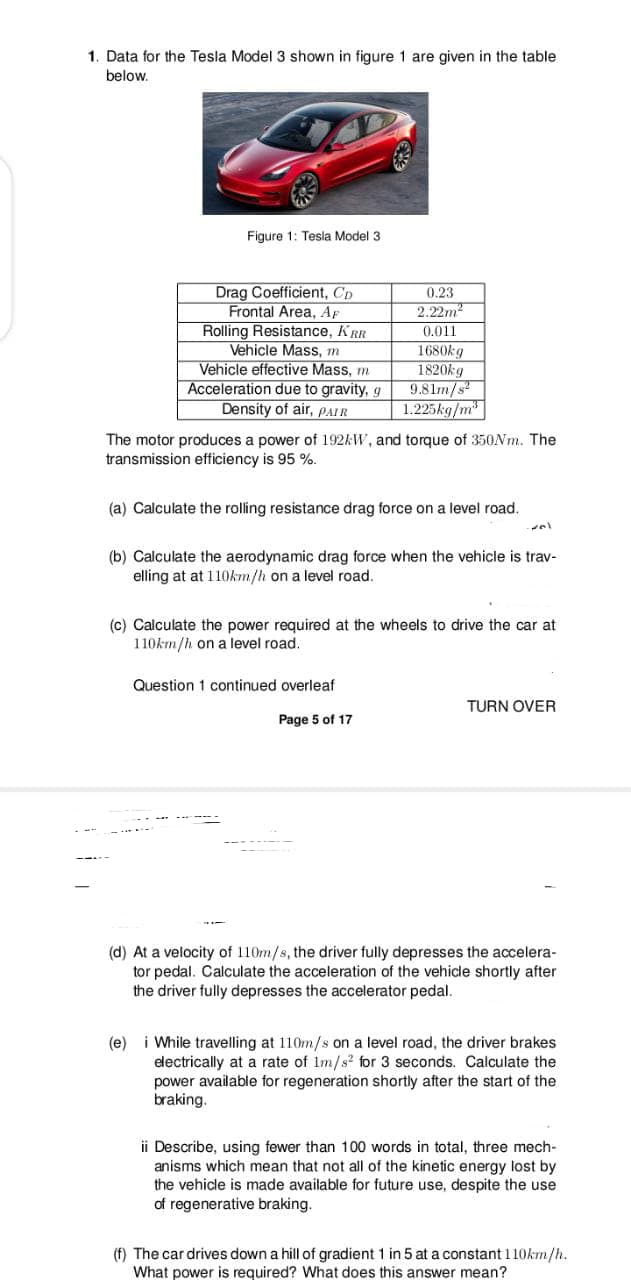Data for the Tesla Model 3 shown in figure 1 are given in the table below. Figure 1: Tesla Model 3 Drag Coefficient, Cp Frontal Area, AF Rolling Resistance, KRR Vehicle Mass, m Vehicle effective Mass, m Acceleration due to gravity, g Density of air, PAIR 0.23 2.22m2 0.011 1680kg 1820kg 9.81m/s 1.225kg/m| The motor produces a power of 192kw, and torque of 350Nm. The transmission efficiency is 95 %. (a) Calculate the rolling resistance drag force on a level road. (b) Calculate the aerodynamic drag force when the vehicle is trav- elling at at 110km/h on a level road. (c) Calculate the power required at the wheels to drive the car at 110km/h on a level road.
Data for the Tesla Model 3 shown in figure 1 are given in the table below. Figure 1: Tesla Model 3 Drag Coefficient, Cp Frontal Area, AF Rolling Resistance, KRR Vehicle Mass, m Vehicle effective Mass, m Acceleration due to gravity, g Density of air, PAIR 0.23 2.22m2 0.011 1680kg 1820kg 9.81m/s 1.225kg/m| The motor produces a power of 192kw, and torque of 350Nm. The transmission efficiency is 95 %. (a) Calculate the rolling resistance drag force on a level road. (b) Calculate the aerodynamic drag force when the vehicle is trav- elling at at 110km/h on a level road. (c) Calculate the power required at the wheels to drive the car at 110km/h on a level road.
Principles of Heat Transfer (Activate Learning with these NEW titles from Engineering!)
8th Edition
ISBN:9781305387102
Author:Kreith, Frank; Manglik, Raj M.
Publisher:Kreith, Frank; Manglik, Raj M.
Chapter1: Basic Modes Of Heat Transfer
Section: Chapter Questions
Problem 1.2DP
Related questions
Question
pplz provide answer for q1 part f for upvote asap

Transcribed Image Text:1. Data for the Tesla Model 3 shown in figure 1 are given in the table
below.
Figure 1: Tesla Model 3
Drag Coefficient, Cp
Frontal Area, Ap
Rolling Resistance, KRR
Vehicle Mass, m
Vehicle effective Mass, m
Acceleration due to gravity, g
Density of air, PAIR
0.23
2.22m2
0.011
1680kg
1820kg
9.81m/s
1.225kg/m
The motor produces a power of 192AW, and torque of 350N.. The
transmission efficiency is 95 %.
(a) Calculate the rolling resistance drag force on a level road.
(b) Calculate the aerodynamic drag force when the vehicle is trav-
elling at at 110km/h on a level road.
(c) Calculate the power required at the wheels to drive the car at
110km/h on a level road.
Question 1 continued overleaf
TURN OVER
Page 5 of 17
(d) At a velocity of 110m/s, the driver fully depresses the accelera-
tor pedal. Calculate the acceleration of the vehicle shortly after
the driver fully depresses the accelerator pedal.
i While travelling at 110m/s on a level road, the driver brakes
electrically at a rate of Im/s? for 3 seconds. Calculate the
power available for regeneration shortly after the start of the
braking.
(e)
ii Describe, using fewer than 100 words in total, three mech-
anisms which mean that not all of the kinetic energy lost by
the vehicle is made available for future use, despite the use
of regenerative braking.
(f) The car drives down a hill of gradient 1 in 5 at a constant 110km/h.
What power is required? What does this answer mean?
Expert Solution
This question has been solved!
Explore an expertly crafted, step-by-step solution for a thorough understanding of key concepts.
Step by step
Solved in 2 steps with 2 images

Knowledge Booster
Learn more about
Need a deep-dive on the concept behind this application? Look no further. Learn more about this topic, mechanical-engineering and related others by exploring similar questions and additional content below.Recommended textbooks for you

Principles of Heat Transfer (Activate Learning wi…
Mechanical Engineering
ISBN:
9781305387102
Author:
Kreith, Frank; Manglik, Raj M.
Publisher:
Cengage Learning

Principles of Heat Transfer (Activate Learning wi…
Mechanical Engineering
ISBN:
9781305387102
Author:
Kreith, Frank; Manglik, Raj M.
Publisher:
Cengage Learning